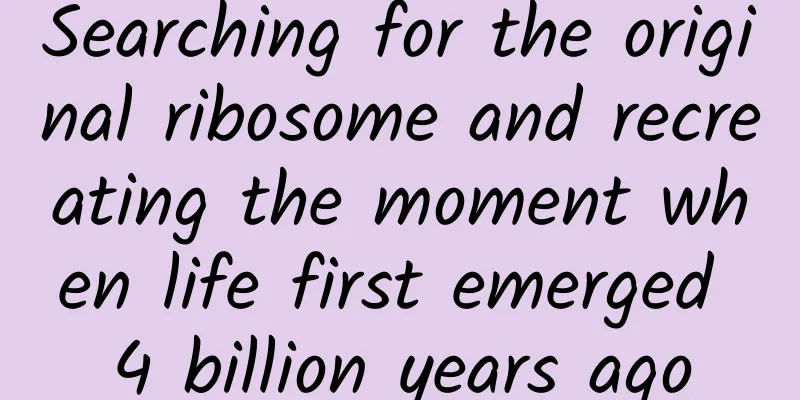Searching for the original ribosome and recreating the moment when life first emerged 4 billion years ago

|
The evolution of life on Earth is a long waltz of three substances: DNA, RNA and protein, but we don't know how this waltz took its first step. Which of DNA and protein came into being first, and how did they help evolution? There is a key role - the primitive ribosome. Finding it may help us explain the origin of life. Written by Gu Shuchen The origin of life has always been a controversial issue in the scientific community. From ancient times to the present, there are different legends around the world, such as the Western creation theory, the Chinese Pangu creation theory, etc. It was not until the 19th century that with the publication of Darwin's book "The Origin of Species", biological science underwent an unprecedented revolution, bringing a glimmer of hope for mankind to reveal the eternal mystery of the origin of life. In Darwin's theory, the evolution of life on Earth, especially the evolution from chemical processes to biological processes, has always been an important issue that he has been pursuing, and the emergence of genetic material that constitutes life is the most elusive. The Proposal of the “RNA World” Today, we know that the most important substances that make up life include DNA, RNA, and proteins, which form an extremely complex network of chemical reactions. Today, all known organisms use the same genetic molecule "nucleic acid" to store information. There are two types of nucleic acids in all living things: DNA (deoxyribonucleic acid) and RNA (ribonucleic acid). DNA is responsible for encoding the genetic information in genes, and is transcribed from DNA to RNA, and genetic genes are ultimately translated into proteins through RNA. As the most important component of cells, proteins ultimately perform most molecular functions, such as assisting in the conversion of DNA to RNA and RNA to protein. This process is the famous "central dogma" in biology [1] . In a sense, the history of life over the past 4 billion years has been a long waltz danced by these three substances, but we do not know how this waltz took its first step. Although these genetic information begins with DNA in today's biochemical mechanism, it is not clear which substance existed first in the history of evolution. Figure 1: Central Dogma Initially, people focused their attention on DNA and protein, because the former is the starting point of genetic information, and protein is the most important functional substance in life activities, but in the end both discussions fell into a dilemma. As the central dogma (Figure 1) shows, it seems that the starting point should be DNA, and it flows from DNA to protein. According to this theory, DNA should appear before protein. However, the problem is not that simple. DNA needs to replicate itself to ensure that life has continued for 4 billion years, and this process cannot be completed by DNA alone. It needs to be replicated by specific enzymes, and these enzymes are all proteins. Therefore, in the discussion of the origin of life, the origin of DNA and protein has become the molecular biology version of "which came first, the chicken or the egg". (Editor's note: Similar problems also exist in the origin of mitochondria, see "The Mystery of the Origin of Mitochondria: How was the Energy Factory of Eukaryotic Cells Built?") Of course, it is impossible for life to have this complete set of sophisticated mechanisms at once. It is more likely that there is a simpler version that can perform all functions. In the 1970s, Thomas Cech, a scientist at the University of Colorado, discovered that RNA molecules can self-catalyze splicing without the need for proteins when studying the "RNA splicing" phenomenon in eukaryotic cells [2] . This was the first time that RNA molecules were proven to be not just passive carriers of genetic information. They can also have the catalytic function of proteins and participate in cellular reactions. Subsequently, Sidney Altman, a scientist at Yale University, discovered that the RNA part of the ribonuclease P of Escherichia coli also has the catalytic activity of the whole enzyme [3]. Both discoveries overturned the traditional concept that all enzymes are proteins, and allowed them to share the 1989 Nobel Prize in Chemistry. These discoveries show the ability of RNA. It can not only replace DNA in encoding genetic information, but also have the enzyme catalytic function of protein. In other words, RNA can shoulder the two important tasks of storing genetic information and catalyzing reactions. This means that RNA molecules may leave DNA and protein behind and dominate the world. This discovery led another Nobel Prize winner, Walter Gilbert, to put forward the "RNA World" theory in Nature magazine [4]. The "RNA World" theory believes that life may have initially appeared in the form of RNA, and as the environment changed, it evolved into today's DNA and protein. The original RNA had the same function of storing genetic information as today's DNA molecules, and also had the same catalytic function as proteases, providing all the necessary prerequisites for early cells or life movements. Do primitive ribosomes exist? Does the "RNA world" point out the mystery of the origin of life? No, there are still many problems with this theory, such as how RNA alone can produce proteins. In cells, protein production is the transcription of genetic material from DNA to mRNA (messenger ribonucleic acid), and then converted into proteins or polypeptides (which can be regarded as mini proteins) according to the sequence of bases in mRNA. This process needs to be completed in the "ribosome" organelle in the cell. Therefore, ribosomes must first exist to produce proteins. So some scientists have proposed that at the origin of life, when RNA evolved the ability to synthesize proteins, there should be a "protoribosome" (protoribosome), and this protoribosome is even "meta-life". Whether this protoribosome of meta-life exists has become a very important argument in this scientific hypothesis. Supporters either find it in nature or create this meta-life in the laboratory. Recently, research on creating meta-life in the laboratory has made important progress. In February 2022, Yonath's team from the Weizmann Institute of Science in Israel published a paper in Nucleic Acids Research, stating that they had reconstructed the original ribosome in the laboratory and reproduced the process of its protein synthesis[6]. In 2000, scientists published the precise structure of the complete ribosome, an achievement that earned them the 2009 Nobel Prize in Chemistry, including Ada Yonath. In 2000, Yonath's team identified the structure of the ribosome, which is composed of proteins and RNA and arranged into two subunits of different sizes [5]. Although these materials came from extreme microorganisms, as the ribosome structures of other organisms were published, they noticed some regularities in the ribosome structure: deep in the core of the large subunit, there is a semi-symmetrical structure. This area contains a pocket-like structure composed of ribosomal RNA, called the peptidyl transferase center (PTC). In the process of mRNA translation into protein, amino acids will be placed in the PTC for two-to-two linking. It can be said that it is the PTC that creates the conditions for amino acids to link together. By observing the PTCs of different species, they found that although the nucleotide sequence of the structure varies from species to species, the shape of each PTC is the same. Ada Yonath and her team speculated that this semi-symmetrical region of PTC is likely the most primitive structure of the ribosome, and that the current ribosome may have evolved from this structure. It was precisely because of this speculation that they first proposed the concept and idea of "primitive ribosome". Figure 2: 3D structure of the original ribosome[6] Through in-depth analysis of the symmetry of PTC, they found that this is a pair of RNAs with similar shapes, which form a semi-symmetrical funnel-shaped pocket structure with incredible precision. During the translation process, tRNA (transfer RNA) carrying amino acids will carry amino acids into the funnel. When the amino acids are close enough in the center of the funnel, they will link together to form peptide bonds. Therefore, they proposed a model of a "primitive ribosome" that may have appeared on the early Earth. This primitive ribosome only needs two L-shaped RNAs with similar shapes, consisting of 60 and 61 nucleotides respectively (Figure 2). They speculated that in such a primitive ribosome, the pocket-shaped structure formed by RNA can link amino acids together to form small peptides [6]. But when Yonath and her team first proposed this conjecture, there was no experimental evidence to show that such a structure could actually exist and work as everyone imagined. To prove this hypothesis, Yonath and her team had to repeat the process or reconstruct the structure in the laboratory. The first step of the experiment was to construct this theoretical primitive ribosome. Through the analysis of modern ribosomes, they spent a long time stripping away anything that looked unrelated to the primitive ribosome from the current ribosome, leaving only enough RNA to create the semi-symmetrical pocket structure that forms the core of the PTC. The second step of the experiment was to prove that this hypothetical primitive ribosome could absorb two amino acids and link them together to form a polypeptide. But this process is not easy. Even if the primitive ribosome can work, it may be very inefficient because there is no protease involved, and the polypeptide that can be produced is so small that it will be difficult for researchers to detect. Therefore, the project was also relayed by different researchers, and it took more than 15 years to finally confirm that the "primitive ribosome" can link two amino acids to form a polypeptide [6]. Of course, such a "Nobel Prize-level question" must have attracted the attention of countless scientists. Yonath's team is not the only team tracking the "primitive ribosome". Professor Koji Tamura of Japan was also inspired by the PTC semi-symmetric core pocket. His team successfully created a similar functional primitive ribosome [7], which also verified the "primitive ribosome" hypothesis proposed by Yonath. These two works not only fill in more details for the study of the origin of life, but also open the door to molecular biology research. Now, many researchers are studying primitive ribosomes or similar things as tools for developing new molecular biological research. Because ribosomes can synthesize proteins. This kind of ribosome is not limited by amino acids and can produce new biological proteins or new biological molecules, such as right-handed amino acids (the amino acids that currently constitute life are all left-handed). And this synthesis method can be cheaper and more environmentally friendly. Multiple Questions about the Origin of Life Of course, the origin of life may not be so simple. Some scholars believe that the primitive ribosome is just a guess about the origin of the ribosome. The primitive ribosome structures of the two laboratories are exactly the same as the modern PTC structure, and we still don’t know much about the evolution of the ribosome. This result only proves that the PTC structure has the ability to synthesize proteins, but it is not enough to prove that today’s ribosomes evolved from the primitive ribosomes with the PTC structure. Some other scholars also pointed out that polypeptides may have appeared on the early Earth in other ways. For example, amino acids plus α-hydroxy acids (a group including lactic acid and citric acid) may form polypeptides under the cool, humid and hot, dry climate cycles of the early Earth, and this process does not require RNA to participate [8] . In 2022, another research team used RNA bases (although not the A, C, G, and U bases used in the modern RNA code) to link peptides together [9]. This result also shows that the linking of amino acids may also occur in the "RNA world" without ribosomes. The way these proteins are produced is nothing like the way nature currently makes proteins in RNA. For many years, scientists have been exploring what form of matter is responsible for the great mission of "the starting point of life", but there is still a lot of research to be done on the origin of life. For example, we need to figure out how RNA acquired the ability to replicate itself; we also need to discover how early ribosomes recognized specific peptides encoded by the original mRNA. These processes, coupled with the ability to synthesize peptides, will provide more possibilities for the origin of life. Four billion years ago, the "primordial soup" of the ancient Earth underwent a series of chemical reactions as the surrounding environment changed, eventually producing a substance that became the starting point for billions of colorful lives today. How exactly it came into being and gradually evolved? Perhaps this will always be the goal of human exploration, and will inspire generations of curious people like us. References [1] Crick F. Nature. 1970 Aug 8;227(5258):561-3. [2] Kruger, K. et al. Cell 31, 147–157 (1982) [3] Stark BC. et al. Proc Natl Acad Sci US A. 1978 Aug;75(8):3717-21. [4] Gilbert, W. Nature 319, 618 (1986). [5] Schluenzen, F. et al. Cell 102, 615–623 (2000) [6] Bose T et al. Nucleic Acids Res. 2022 Feb 28;50(4):1815-1828. [7] Mr. Kawabata et al. Life (Basel). 2022 Apr 12;12(4):573. [8] Forsythe, JG et al. Angew. Chem. Int. Edn Engl. 54, 9871–9875 (2015). [9] Müller, F. et al. Nature 605, 279–284 (2022). This article is supported by the Science Popularization China Starry Sky Project Produced by: China Association for Science and Technology Department of Science Popularization Producer: China Science and Technology Press Co., Ltd., Beijing Zhongke Xinghe Culture Media Co., Ltd. |
<<: The strongest sandstorm this year is coming, why can't the shelterbelt forest stop it?
>>: This spectacle will happen! Tonight! It will be visible from most of our country!
Recommend
Finding the secrets of forest remains! 310 million-year-old fossil wood group in Yangquan, Shanxi Province is "out of the circle"
Science and Technology Daily (Reporter Han Rong) ...
What are the catalysts for artificial rainfall? Will the use of these catalysts affect the environment?
Did you know that salt has many uses? In addition...
The gynecological items in the physical examination are so embarrassing, can I not do them?
In the new year, have you done your annual physic...
A brand marketing program operation manual
This is a brand marketing operation manual that I...
How to play information flow advertising? It took 300,000 yuan to summarize the experience!
Industry Overview: According to incomplete statis...
With these tools, you can easily create high-conversion landing pages even if you don’t know design or code!
The landing page is an important part of relation...
37.2 trillion, what does that mean? He explores the mysteries of life from massive cell research
37.2 trillion, what does that mean? Every human b...
Lenovo: We have the responsibility to promote the better development of the PC industry in China
Compared with the fierce competition in the mobil...
Introduction to 360PC resource advertising promotion display styles!
PC Resources: Mainly promote three major advertis...
"K Bao" Valieva's free skating ended dismally: Doping and competitive sports, the never-ending cat-and-mouse game
Written by reporter Wang Xueying Edited by Liu Zh...
The color of your quilt really affects your sleep quality! Change it now!
Can the color of the quilt affect your sleep? ——R...
When a high-rise building catches fire, should you run up or down?
In the early morning of February 23, a fire broke...
The biggest full moon of the year appeared in the night sky last night! Where did this "fat" moon come from?
Review expert: Jing Hairong, researcher at Beijin...
When influenza A strikes, doing this right is more effective than grabbing oseltamivir
Audit expert: Gu Haitong Deputy Chief Physician, ...
A complete list of essential tools for app promotion!
APP submission to large channel market: App Store...









